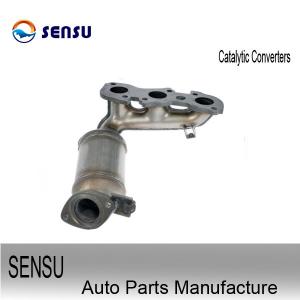
Add to Cart
Carb Compliant 64mm Universal Cadillac Converter 2.5 Inch Stainless Steel Construction
Description of catalystic converter:
Located in the exhaust pipe after the exhaust manifold and before the muffler, its purpose is to convert unburned hydrocarbons in the exhaust gases into harmless elements before they enter the environment.The catalytic converters shell is made of steel much like a muffler, but inside it’s much different.Catalyst materials that coat a ceramic honeycomb-like structure react with harmful gases such as nitrogen oxide and carbon monoxide.After reacting with catalyst materials that coat the honeycomb, the exhaust gases pass harmlessly into the environment.When an engine isn’t running properly and high levels of pollutants or unburned fuel are in the exhaust gas, the catalytic converter can’t keep up.High heat levels result that damage the honeycomb, or the catalysts can become poisoned by substances that render them ineffective. When that happens, the catalytic converter must be replaced.

Application of catalytic converter:
Although catalytic converters are most commonly applied to exhaust systems in automobiles, they are also used on electrical generators, forklifts, mining equipment, trucks, buses, locomotives, and motorcycles. They are also used on some wood stoves to control emissions.[5] This is usually in response to government regulation, either through direct environmental regulation or through health and safety regulations.
Catalytic converters require a temperature of 800 degrees Fahrenheit (426 °C) to efficiently convert harmful exhaust gases into inert gases, such as carbon dioxide and water vapor. Therefore, they are placed as close to the engine as possible.
Types
Two-way
A 2-way (or "oxidation", sometimes called an "oxi-cat") catalytic converter has two simultaneous tasks:
Oxidation of carbon monoxide to carbon dioxide: 2 CO + O2 → 2 CO2
Oxidation of hydrocarbons (unburnt and partially burned fuel) to carbon dioxide and water: CxH2x+2 + [(3x+1)/2] O2 → x CO2 + (x+1) H2O (a combustion reaction)
This type of catalytic converter is widely used on diesel engines to reduce hydrocarbon and carbon monoxide emissions. Because of their inability to control oxides of nitrogen, they were superseded by three-way converters.
Three-way
Three-way catalytic converters (TWC) have the additional advantage of controlling the emission of nitric oxide (NO) and nitrogen dioxide (NO2) (both together abbreviated with NOx and not to be confused with nitrous oxide (N2O)), which are precursors to acid rain and smog.
Since 1981, "three-way" (oxidation-reduction) catalytic converters have been used in vehicle emission control systems in the United States and Canada; many other countries have also adopted stringent vehicle emission regulations that in effect require three-way converters on gasoline-powered vehicles. The reduction and oxidation catalysts are typically contained in a common housing; however, in some instances, they may be housed separately. A three-way catalytic converter has three simultaneous tasks.